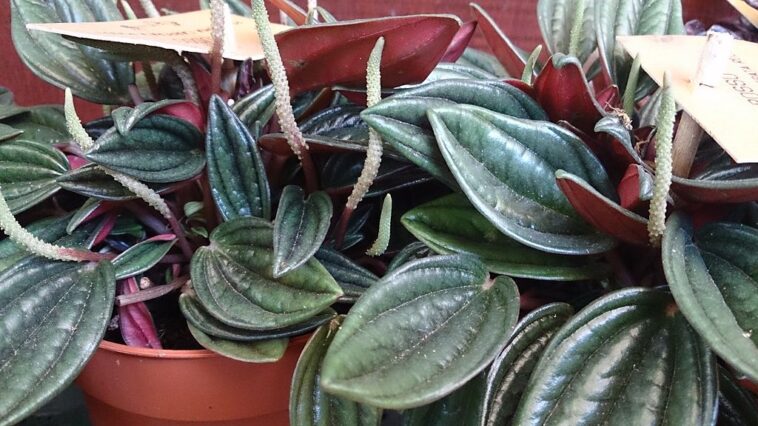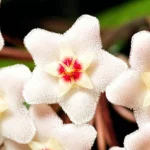Peperomia Rosso is a stunning little plant who will bring colour and style to those low light areas of your household. Peperomia Rosso has gorgeous deep green leaves with distinctive veins in green or blushes of red.
The undersides and stems of Peperomia Rosso range from gorgeous delicate pinkish hues to magnificent deep reds.
Table of Contents
Profile
Rosso is a compact fellow, with leaves that measure around 2-3cm long. It throws out long, slender spikes containing both male and female flowers that typically bloom in spring and summer.
These scentless flower spikes generally reach a length of around 7cm, and while they aren’t conventionally beautiful, they do add loads of quirky personality.
Character
Peperomia Rosso is an easy going plant, who is generally undemanding of its carers. The biggest problem they face is overwatering, which will cause leaves to droop and wilt and roots to rot.
How To Care For Peperomia Rosso
Peperomia Rosso Watering
Peperomia are succulents, and therefore have low water requirements. Wait until the soil has dried out before watering thoroughly. Avoid wetting the leaves, and no need to mist.
To check for watering requirements, pop your finger into the soil. If the top two inches are dry (second knuckle down!) – it’s time to water! Peperomia are also good at letting you know when they need water. The leaves will wrinkle and be bendy’ (rather than firm) to the touch.
In this case it is simply a task to give them a nice drink and Peperomia Rosso will perk up within hours. As with most houseplants, under watering is far less a problem than over watering.
Best Soil for Peperomia Rosso
Peperomia Rosso enjoys an airy, well-draining soil and hates having wet or soggy feet. The ideal soil mix is rich and incorporates perlite, sand or gravel to avoid the soil from compacting over time. A succulent mix from your local garden center would be ideal.
Lighting Requirement
Perfect for those tricky low light areas, Rosso enjoys a range of light levels from dim to bright. Direct sunlight will burn the leaves, so take care when placing near or next to windows.
Temperature Requirement
Peperomia Rosso is a tropical plant that originate in South America. It likes steady temperatures that range from 55 – 75 degrees Fahrenheit, or 13 – 24 degrees Celsius. Peperomia Rosso doesn’t like change, so keep it away from heating and air-conditioning vents.
How To Propagate Peperomia Rosso
Peperomia Rosso is super easy to propagate, and you can choose between stem, leaf and tip cuttings which can be placed into either soil or water. Stem cuttings are generally best in water, while leaf and tip cuttings work well in soil.
If you propagate with stem cuttings in water:
- Select a longer piece with a leaf (make sure the stem is long enough to be able to sit in water).
- Submerge the stem in water, using the leaf as an anchor on the edge of the recepticle.
- Wait. It usually takes around four weeks for the babies to grow. And yes, they will grow under the water!
- Transplant to soil when the roots are several centimetres long. Make a little hole in some clean, fresh soil, pop in the roots, and leave the mother leaf and babies on top. This is fiddly work and you might need to use a toothpick to help you along. The mother leaf will eventually die as the babies extract their nutrients from her.
If you propagate with leaf or tip cuttings in soil:
- Snip off a large, healthy leaf from your plant.
- Make a hole in some well draining soil mix and pop the leaf in so about half is under the soil and the other half is visible above the soil.
- Keep moist, but not wet.
- Cross your fingers and wait! Propagation will not work every time, so it’s generally best to do a few pieces at the same time.
- Babies will appear at the base of the mother leaf after around four weeks.
- It’s very important not to get excited and overwater at this stage! The tender new roots are very susceptible to rot.
- The root system of peperomia are shallow, so it’s best not to rush into planting them into a new container right away.
Fertilizer
Strictly speaking, if you have the soil mix right, Peperomia Rosso doesn’t need fertilizing and will grow perfectly happily year in year out, with only a soil refresh in spring.
If you are the kind of person who absolutely must fertilize, however, then feed only in spring with a balanced 10-10-10 water soluble fertilizer.
Repotting Peperomia Rosso
Like most houseplants, Peperomia Rosso will benefit from repotting every two to three years. This is to prevent compaction of the potting mix, which is a problem because reduces drainage over time.
When repotting, choose a pot of a similar size, or one size up. Too large a pot will result in retention of excess of water in the soil and your beautiful peperomia Rosso will struggle to breathe.
When repotting, try to remove as much of the old potting mix as possible from the roots, before carefully placing the plant in fresh new soil and patting gently around the base. Water in thoroughly.
Pests and Diseases
Peperomia Rosso is a hardy soul and generally quite resilient to pests. The most common pests that can hang around are the bane of every overwatering houseplant parent: fungus gnats.
Fungus gnats are tiny black flies that hang around the plant and soil. While the gnats themselves are harmless, it’s their larvae which do all the damage by feeding off the roots of the plant.
The best treatment for fungus gnats is by not overwatering in the first place! But if you do find yourself with an infestation, the first thing you need to do is to isolate the plant (so your other plants don’t become infected) and let the soil dry out.
You can then try some home remedies such as top-dressing the soil with sand or cinnamon powder, which prevents the flies from being able to enter the soil. There are also many commercial products which you can use to treat fungus gnats.
Pets and Children
Peperomia Rosso is non toxic and therefore safe for your pets and children to be around.
Mokkie, CC BY-SA 3.0 https://creativecommons.org/licenses/by-sa/3.0, via Wikimedia Commons


